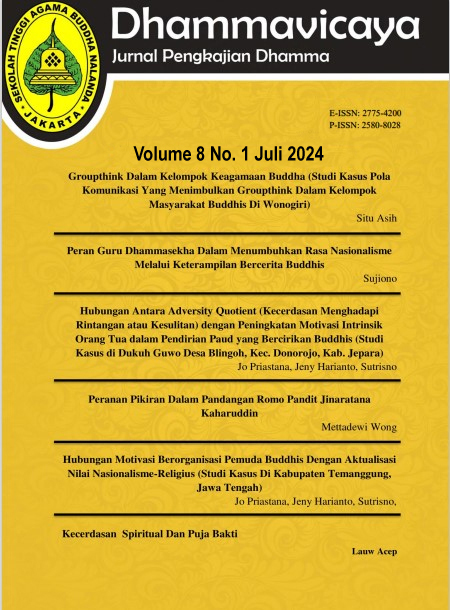Keluarga Buddhis Theravada Indonesia (KBTI): Urgensinya Mendukung Lembaga Pendidikan Formal Buddhis sebagai Nibaddha Kusala
DOI:
https://doi.org/10.47861/dhammavicaya.v8i1.1642Keywords:
Buddhist formal education institution, Cetiya, Dhammacakka, Nibaddha Kusala, ViharaAbstract
Since Dhammacakka (599BCE/528BCE) to its golden era (450-1193CE), the development of Buddhism cannot be separated from the role of the world of education, but the spirit of Buddhist support for the development of formal education is not sustainable in the 21st century. The phenomenon that occurs in Indonesia is that Buddhists build more places of worship (monasteries/cetiya/arama) than formal educational institutions with a percentage reaching 10:1000. This study aims to determine the perspective of the Indonesian Theravada Buddhist Family (KBTI) in seeing the importance of supporting formal Buddhist educational institutions as a field of empowerment that is continuously rewarding (Nibaddha Kusala). Qualitative methods with historical descriptive analysis and heuristics were chosen to find meaning in the form of historical data on the development of Buddhist education, then triangulated with data from interviews with KBTI member organizations. The results of this study indicate that all KBTI member organizations consider formal educational institutions to be an important thing to support, but there is still room for apathy and a lack of integration with each other in supporting formal Buddhist educational institutions.
References
BKPBI. (2001). Data sekolah. Retrieved from http://bkpb.org/sekolah. (Accessed February 2, 2021)
Direktorat Sejarah dan Nilai Budaya DIRJEN Kebudayaan Kementerian Pendidikan dan Kebudayaan. (2014). Kiriman catatan praktik Buddhadharma dari Lautan Selatan. Diterjemahkan dari versi Bahasa Inggris A record of the Buddhist religion as practiced in India and the Malay Archipelago (A.D. 671-695) dari versi asli kitab catatan Nanhai Ji Gui Neifa Zhuan (Yi Jing/It Tsing) oleh J. Takakusu, B. A., Ph. D. Oxford, 1896. Jakarta: Direktorat Sejarah dan Nilai Budaya.
Hidayat, N., Sutrisno, S., & Permatasari, T. (2023). Transformasi Sekolah Tinggi Agama Buddha Nalanda menjadi Institut Agama Buddha Nalanda: Tinjauan studi kelayakan dalam konteks sosial budaya. Innovative: Journal of Social Science Research, 3(5), 4174–4189. https://j-innovative.org/index.php/Innovative/article/view/5331
Jo Priastana. (2016). Filsafat Buddha. Jakarta: Yayasan Yasodhara Puteri.
Portal Data Terpadu DKI Jakarta. (2011). Jumlah sarana ibadah menurut kabupaten kota. Retrieved from http://Data.Jakarta.go.id. (Accessed February 2, 2021)
Pusdiklat Perpustakaan Nasional. (2019). UU No. 20 Tahun 2003 tentang Sistem Pendidikan Nasional. Retrieved from https://pusdiklat.perpusnas.go.id/public/media/regulasi/2019/11/12/2019_11_12-03_49_06_9ab7e1fa524ba603bc2cdbeb7bff93c3.pdf. (Accessed March 25, 2021)
Sangha Theravada Indonesia. (2022). Keluarga Buddhis Theravāda Indonesia (KBTI). Retrieved from https://sanghatheravadaindonesia.or.id/index.php/tentang-kami/kbti. (Accessed March 4, 2022)
Seng Hansen, S. (2008). Ikhtisar ajaran Buddha. Yogyakarta: Insight Vidyasena Production.
Sudharma, B. (2007). Buku pedoman umat Buddha (Edisi Revisi Ke-5, Hal. 129–192). Jakarta: FKUB DKI Jakarta.
Sukarno, S. (2017). Ekspektasi umat Buddha terhadap pendidikan bercirikan agama Buddha di sekolah Buddhis. Jurnal Pencerahan, 9(9), 10–25. STABN Sriwijaya.
SuttaCentral (Offline Legacy Version). (2005). Samyutta Nikāya. (Accessed February 2, 2021)
SuttaCentral. (2005). Dhammapada. (Accessed February 2, 2021)
Tjakra, W. (2019). Pendidikan Buddhis di era milenial. Jurnal Dhammavicaya, 3(1), 22–27. Jakarta: STAB Nalanda.
Downloads
Published
How to Cite
Issue
Section
License
Copyright (c) 2025 Dhammavicaya : Jurnal Pengkajian Dhamma

This work is licensed under a Creative Commons Attribution-NonCommercial-ShareAlike 4.0 International License.






